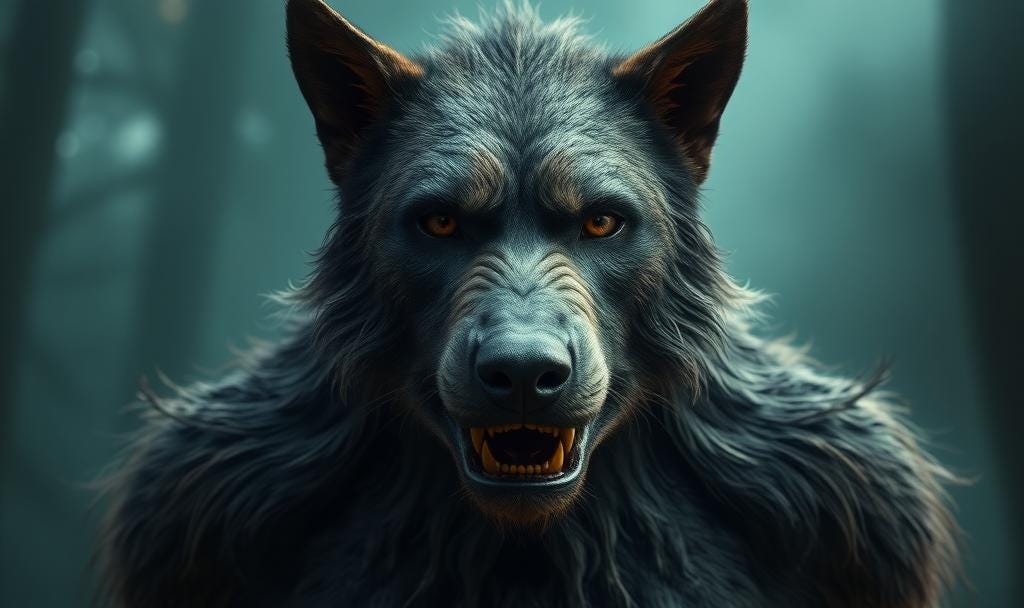Enter the Dogman, Maybe
What can the coastal sea wolf teach us about the ecological possibility of Bigfoot's cryptid cousin?

Last time on TSB I explored how witnesses make judgments about height. We learned that researchers in the field of eyewitness testimony agree that witnesses tend to underestimate height, but the question remains whether this research can be generalized to wildlife (and Bigfoot) encounters. I’m not so sure it can be, but this got me thinking about a Dogman encounter I listened to several years ago.
One factor that could improve height estimates and reduce observation errors is technology. Technology-assisted observation can increase our confidence in height estimates and in the witness report more generally. And when it comes to Dogmen encounters, our ability to dismiss observation errors becomes critical. Yeah, it’s important with Bigfoot encounters, too, but Dogmen encounters are another thing altogether. Here’s why.
My Thoughts on Dogmen
When I first became interested in Bigfoot, I had no idea that witnesses were reporting encounters with another unknown bipedal creature in North America. These Dogmen encounters are difficult to accept. At least with Bigfoot there’s precedence for such an animal and, ecologically, Bigfoot makes sense: a primate –whether human or non-human – living in montane forests in North America. There are primates living in rainforests and jungles in Africa, Asia, and South America, too.
But with Dogmen, there is no precedence aside from folklore and Hollywood movies. There is no biological or ecological basis for such creatures. However, there is something fascinating about wolves and their ability to adapt to a variety of environments, and this could give us insight into the possibility of Dogmen.
The Coastal Sea Wolf
In a previous post, I wrote about the enigmatic African wolf in Egypt. Despite the local people arguing that the Egyptian jackal prancing around their region is a wolf, most of the scientific community dismissed the claims, saying there are no wolves in North Africa and such claims are clearly cases of misidentification. Then a DNA test confirmed these jackals are in fact an ancient line of the grey wolf.
This same science-knows-best pattern reared up in coastal British Columbia (BC) with the sea wolf, a.k.a. the marine wolf. The First Nations people in the region knew long ago that the coastal wolf population was unique from its inland cousins1. As it turns out, genetic testing in the early 2000s proved the indigenous people knew what they were talking about2.
What intrigues scientists most about these unique grey wolves is their ability to adapt to the coastal ecosystem, which is starkly different from the inland forests. According to scientists like Jennifer Leonard3, wolves can colonize new habitats and become genetically distinct from other wolf populations within a few thousand years. But, Leonard says, while some differences are morphological -- for example, fur density or body size in the case of the sea wolf -- most differences are behavioral. I’ll go a step further and point out that the sea wolf has not developed extra-large, webbed paws and broad flat tails for swimming, or sprouted gills to breathe underwater. At least not yet, but who knows. At some point a fish learned to walk on land and breathe air; why couldn’t things go in the other direction.
So, what makes the sea wolves stand apart from the inland grey wolves? True to their name, sea wolves are swimmers, with wolf packs swimming from island to island off the coast of BC. One island on which these wolves have been spotted sits 13 kilometers from the nearest land mass. Their diet is also different, with 85% of it being marine-based, such as otters, seals, fish, and shellfish. These wolves have adapted to this coastal ecosystem to such an extent that they have become different -- genetically, morphologically, and behaviorally -- from other Canidae.
Back to Dogmen
It seems genetic variations in wolves can happen quickly on the time scale, perhaps a few thousand years. Some of these changes show up as marginal, morphological variations. Most changes, however, are behavioral. The question then is, what type of habitat or ecosystem would lead to the evolution of a Dogman-wolf, characterized by bipedalism, broad shoulders, muscular arms, and human-like claws? None, really. There are two main reasons for this, in my opinion, based on my cursory review of wolf-science and what I have heard about Dogmen.
Wolves survive today in most known habitats — deserts, mountains, rainforests, artic tundra, whatever. All these wolf populations are recognizable as quadrupedal canines. It’s no wonder that scientists confuse jackals with wolves in Africa and inland grey wolves with coast sea wolves in BC. Observer errors are common. My point is that if there's a habitat on earth that gives survival advantage to an upright walking, broad-shouldered canine, we should already know about it.
Even if there is such a habitat that would produce Dogmen, sightings of Dogmen happen all around North America rather than in a single, defined geographic area. For known wolves, it is the unique ecosystem that allows for the emergence of distinctive traits. And to develop those traits, wolves remain within their ecosystem rather than move between different ones. In fact, the coastal habitat of the sea wolf and inland habitat of the grey wolf are geographically adjacent, but the two populations do not interact. I would expect Dogmen to remain within their particular habitat, rather than pop up in many different ones.
In my understanding, then, Dogmen are inconsistent with what we know about genetic and morphological variations among wolves. Next to Dogmen, the existence of Bigfoot looks perfectly plausible. Still, I’m making an assumption that Dogmen, if they exist, are in the Canidae family and that their evolution parameters would track with wolves. This could be a false assumption. Weird, science-defying creatures are not absent from our world. Enter the Duck-billed Platypus, a mammal that lays eggs, has a bill like a duck, and males can deliver venom through spurs on their hindlegs. It’s a collage of different species. Oh, nature, you are a crazy one!
For the sake of argument let’s say the existence of Dogmen is highly unlikely; it’s no platypus. What, then, are witnesses encountering? Even if you’re open to a Bigfoot species, when it comes to Dogmen your inner-debunker shines through: it’s observer error or poor memory. That was my thinking, too. The snout, the pointed ears. Yeah, OK, this could be a bear. Hell, it could even be a Bigfoot if such things existed. But before we join the debunker ranks on Dogmen, let’s get back to my earlier point on technology-assisted observation and take a look at a Dogman encounter.
The Oklahoma Dogman
David, our witness, shared his encounter on a podcast interview with Wes Germer of Sasquatch Chronicles4. David is a long-time hunter and had geared up for his Oklahoma coyote hunt. For those unfamiliar with shooting technologies, David had a mil dot reticle (which is a type of scope) on his rifle. You can learn about these gadgets through the links in the footnotes56. For our purposes, just understand that this technology enables the hunter to accurately measure not only distance to a target but also the target size.

Enough of the mildots. Here’s the climactic point in David’s interview:
I was convinced a black bear was going to run right over me. I never seen nothing like this, so, it kept coming and when it got to about 400 yards, it just, all of a sudden it stood up. And that's when I freaked out. I mean this thing stood up, and when it stood up in the reticle, I could tell it was about 8 feet tall, and I mean, I -- hair stood up on the back on my neck. It’s the only time I've ever been concerned in the woods or any hunting, any expedition, ever. I've hunted all over the United States, in just about every state you could think of, for coyotes, lions, and, hunted at night all over the desert. Bow hunted all over Oklahoma, Colorado, and different places, you know. And uh, never had a concern, ever, even with bears. I was never afraid of bears. And uh, this thing, when it stood up, I mean it kind of shook me a little bit.
And so I had to look twice at what I was looking at, you know. So, I could tell it was about 8 feet tall on the mil dot reticle. So I cranked the scope up to 24 power, and that's when I really got to see him. Uh, I looked right into its face. And this thing looked like a bigfoot. It was... shoulders super wide, you know, 3 foot wide at least maybe 4. Uh, it had a dog's face. You could tell, definitely tell the snout and the nose. And the ears were like a Doberman pinscher, they were sticking straight up about 3-4 inches high.
For context — and I did this with Jay’s sighting in Northern Tennessee in the post The Inscrutable Misidentification Argument linked below — if David is viewing this creature through his scope at 24x, it’s similar to this creature standing roughly 400yards / 24x = 16.67yards, or about 50 ft in front of him. This is about 10 feet closer than a pitcher is to a batter in major league baseball. It’s pretty freakin’ close.
Just from the above snippet of David’s encounter a debunker would be hard-pressed to to make an argument for observer error or even poor memory. But there’s more to this encounter that could help in our analysis.
Bottomline
If we take the African wolf and the coastal BC sea wolf as examples of canine adaptations to environments, then it seems unlikely that Dogmen could be an ancient line of wolves. Dogmen are just are too damn different. I suppose the situation could be the opposite: Dogmen are the ancient line from which wolves evolved. I don’t know. This feels like a rabbit hole to me.
On the other hand, the people of Egypt and of coastal BC knew a wolf when they spotted one, despite rejection from the scientific community. David alone is not an indigenous community but he’s one of many in the hunting community who have reported encounters with these creatures. Should we simply reject and ignore these reports, just as the scientific community did in these other cases? I’m not ready for that step until we take a closer look at David’s encounter.
Next time on TSB
There’s much on my mind, but next week I want to dig into David’s encounter in Oklahoma. While we might dismiss observer error and poor memory with some confidence, we still have arrows in our Theory of Deception quiver. First, though, I want to explore the dramatic arc of David’s narrative and see how it maps to our Bigfoot narrative framework7. Then I’ll shoot our remaining deception arrows at David and we’ll see what sticks. Stay tuned, troopers, we’re heading into the plains and there’s a storm brewing!
As always, thanks for reading and don’t be a Stranger,
DC | TSB
I really enjoyed this article about sea wolf by Ziya Tong, 2021. There’s beautiful photography, too. https://canadiangeographic.ca/articles/the-amazing-sea-wolves-of-the-great-bear-rainforest/
Find the sea wolf DNA results from Violeta Munoz-Fuentes and colleagues (2009) here: https://doi.org/10.1111/j.1365-2699.2008.02067.x]
You can find Jennifer Leonard’s article on evolution in grey wolves here: https://www.evolutionary-ecology.com/open/v16n06/eear2913.pdf
you can listen to the encounter here: https://sasquatchchronicles.com/sc-ep100-the-hunter-or-the-hunted/
Everything you want to know about mil-dot-reticles: https://www.targettamers.com/rifle-scopes/mil-dot-explained/
More of everything you want to know about mil-dot-reticles: https://ustacticalsupply.com/mildotreticlereview.aspx
See my post for the Bigfoot narrative framework:







